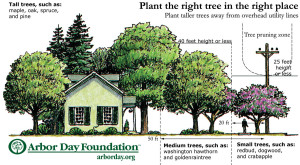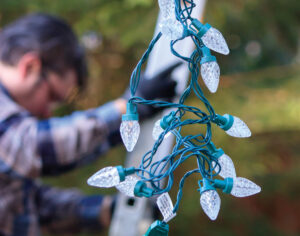 A properly selected and planted tree can add beauty, value and energy efficiency to your landscape. On the other hand, a poorly selected and planted tree can become high maintenance, expensive, dangerous and short-lived. The Energy Education Council has advice to help you select the tree that is best for your yard.
A properly selected and planted tree can add beauty, value and energy efficiency to your landscape. On the other hand, a poorly selected and planted tree can become high maintenance, expensive, dangerous and short-lived. The Energy Education Council has advice to help you select the tree that is best for your yard.
Spring is a good time for tree planting. April weather is known for being wet and not too cold or hot for a new tree. In fact, Arbor Day-a national observance and celebration of the importance of trees-falls in April. Here in Illinois it is the last Friday of April each year.
This is an excellent time of year for tree planting. With research and preparation, your tree will be a healthy and beautiful addition to your home for years to come.
One of the first considerations is the purpose of your tree. Will your tree be needed for shade, a windbreak or beauty? These considerations will affect what tree is suitable for you, and where it should be planted.
Dense evergreens provide a good wind block, while leafy deciduous trees provide shade in the summer. No matter what purpose, the best option is always native trees. They require less maintenance and will live longer. You can get more information about native growing trees from a regional University Extension office. The Arbor Day Foundation has a free tree wizard tool that will help you select the best tree for your needs. It
is available at www.arborday.org/
shopping/trees/treewizard/intro.cfm.
The next step is to decide where you will plant your tree. For a windbreak, plant trees to the north and northwest. For shade, plant trees to the east and west of your home. Remember that fast-growing trees are more brittle, and likely to be damaged in a storm. Plant these trees farther from your home to protect your home from damage.
Select planting locations that will not interfere with your utility lines or power poles. Tall growing trees with a mature height of greater than 40 feet should be planted 50 feet away to avoid future pruning. A mature height of less than 25 feet is recommended for trees planted near power lines. Keep in mind that trees should never be planted directly under power lines, near poles, or too close to electrical equipment. Besides creating the potential for outages and blinking lights, trees planted close to power lines can become a real hazard for children climbing in trees, or someone trying to trim the tree limbs close to the power lines. This is a job always best left to professionals.
Shawn Miller can tell you why planting trees close to power lines can lead to future disasters. Shawn was hanging Christmas lights at his mother’s house like he did every year, when tragedy stuck. The string of lights Shawn held made contact with a power line as he threw it into a tree. Shawn suffered 27 exit wounds, the loss of one hand, and a finger on another but miraculously survived. Shawn and his mother hope their lesson can save other families from harm. You learn more from Shawn and others by going to safeelectricity.org and our safety videos under the Information Center.
Finally, don’t forget there can be unseen dangers underground. Before planting, take proper precautions to stay safe. Contact JULIE the Joint Utility Locating Information for Excavators service at 8-1-1 or 800-892-0123 a few days before you want to plant. This free service will mark underground utilities, so you can dig far from these hazardous underground utilities. For more information go to illinois1call.com.
Molly Hall is Director of Safe Electricity. E-mail molly-hall@SafeElectricity.org. Safe Electricity is a public awareness program of the Energy Education Council. www.EnergyEdCouncil.org







